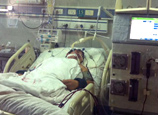
CANBERRA, April 13 (Xinhua) -- Australian researchers developed a mobile laser 3D mapping system called Zebedee to preserve some of the country's oldest and most culturally significant heritage sites, CSIRO, Australia's national science agency, announced on Saturday.
According to a statement from CSIRO, this new joint research initiative between CSIRO and The University of Queensland aims to collect detailed 3D maps of historic sites of Moreton Bay. With the assistance of Queensland Parks and Wildlife Services, the research team has collected data from a number of heritage sites including the 19th century Brisbane River defences at Fort Lytton and Peel Island's leper colony buildings.
At the core of the technology, developed by CSIRO's Autonomous Systems Lab in Brisbane, is a laser scanner that swings back and forth on a spring to capture millions of detailed measurements. Zebedee gives researchers the ability to reliably map an environment in 3D by simply walking through it.
This technology is ideal for cultural heritage mapping, which is usually very time consuming and labor intensive, Dr. Jonathan Roberts, director of CSIRO's Autonomous Systems Lab, said. "It can often take a whole research team a number of weeks or even months to map a site with the accuracy and detail of what we can produce in a few hours."
"Zebedee has allowed us to capture a detailed record of several key cultural heritage sites ranging from those which are fragile and risk of damage through natural disasters to those which are remote and difficult to get to," said Professor John Macarthur, dean and head of the School of Architecture at The University of Queensland.
















 Bird flu takes toll on poultry industry
Bird flu takes toll on poultry industry


![]()
